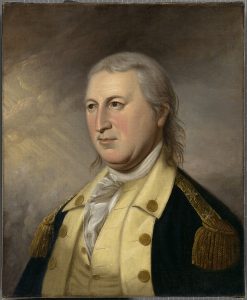Led a Continental Army to Disaster
Biography
 Few people have more complicated Revolutionary War histories than Horatio Gates. An Englishman, Gates first came to America to help the Governor of Nova Scotia, uncle to Gate’s later foe, Lord Charles Cornwallis. Gates was wounded as a captain in Pennsylvania during the French & Indian War. He returned to England and retired from the army, but in 1772 bought a plantation in Virginia. Gates supported independence and became a brigadier general in the Continental Army when war broke out. Early victories in the north brought him disputed fame. For example, he took credit for forcing the surrender of a British army at the Battle of Saratoga (N.Y.), though people then and now question his role versus that of his field commanders. Gates angered Gen. George Washington multiple times. He supposedly took part in a plot to remove Washington, and planned an invasion of Canada without Washington’s knowledge. Placed in charge of the Southern army in 1780 after the fall of Charleston, he led it from N.C. to a disastrous loss at the Battle of Camden (S.C.). Gates fled the battlefield and rode to Hillsborough by way of Charlotte in three days. Branded a coward, he was replaced by Maj. Gen. Nathanael Greene in December 1780. He served again, without notable achievement, for a year at the end of the war. Later he sold his plantation and slaves and moved to a country estate on Manhattan Island, near what is now 23rd Street and Second Avenue. He was elected to one term in the New York State legislature. After his death in 1806, he was buried at Trinity Church in what became the Wall Street District.
Few people have more complicated Revolutionary War histories than Horatio Gates. An Englishman, Gates first came to America to help the Governor of Nova Scotia, uncle to Gate’s later foe, Lord Charles Cornwallis. Gates was wounded as a captain in Pennsylvania during the French & Indian War. He returned to England and retired from the army, but in 1772 bought a plantation in Virginia. Gates supported independence and became a brigadier general in the Continental Army when war broke out. Early victories in the north brought him disputed fame. For example, he took credit for forcing the surrender of a British army at the Battle of Saratoga (N.Y.), though people then and now question his role versus that of his field commanders. Gates angered Gen. George Washington multiple times. He supposedly took part in a plot to remove Washington, and planned an invasion of Canada without Washington’s knowledge. Placed in charge of the Southern army in 1780 after the fall of Charleston, he led it from N.C. to a disastrous loss at the Battle of Camden (S.C.). Gates fled the battlefield and rode to Hillsborough by way of Charlotte in three days. Branded a coward, he was replaced by Maj. Gen. Nathanael Greene in December 1780. He served again, without notable achievement, for a year at the end of the war. Later he sold his plantation and slaves and moved to a country estate on Manhattan Island, near what is now 23rd Street and Second Avenue. He was elected to one term in the New York State legislature. After his death in 1806, he was buried at Trinity Church in what became the Wall Street District.
More Information
- Lewis, J. D., ‘Major General Horatio Gates’, The American Revolution in North Carolina, 2007 <https://www.carolana.com/NC/Revolution/continental_army_horatio_gates.html> [accessed 18 April 2020]
- Rankin, Hugh F., The North Carolina Continentals (Chapel Hill: The University of North Carolina Press, 1971)
- Scythes, James, ‘Horatio Gates’, George Washington’s Mount Vernon <http://www.mountvernon.org/library/digitalhistory/digital-encyclopedia/article/horatio-gates/> [accessed 18 April 2020]
- Sherman, Wm. Thomas, Calendar and Record of the Revolutionary War in the South: 1780-1781, Tenth Edition (Seattle, WA: Gun Jones Publishing, 2007) <https://www.americanrevolution.org/calendar_south_10_ed_update_2017.pdf>



